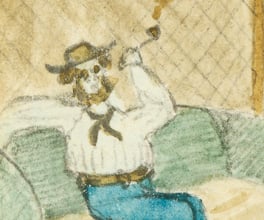The pastoral system
In 1836 squatters from Van Diemen’s Land crossed Bass Strait to settle what was then known as the Port Phillip district of New South Wales, now country Victoria.
The squatters settled the land illegally. It took at least a year for the colonial authorities in New South Wales to realise that there were people squatting in the Port Phillip district. In 1844 the authorities decided that the squatters would pay a Depasturing Licence of £10 per run.
The license allowed the squatters to become pastoralists and to set up where they chose on Crown land. The only limitation to this was a tacit agreement between pastoralists that there would be a distance of three miles (about 5 kilometres) between stations. According to pioneering squatter, Thomas Learmonth:
This regulation in general was sufficient to secure harmony among the adventurers as they arrived [...] but feuds and quarrels with regard to boundaries did take place, which in some cases resulted in blows, though in general, more good-feeling and consideration for the rights of others were observed in the then lawless state of the infant colony than might have been expected.
- Thomas Learmonth
Sayers, C E [ed.] 1983 Letters from Victorian pioneers : a series of papers on the early occupation of the colony, the Aborigines, etc. addressed by Victorian pioneers to His Excellency Charles Joseph La Trobe, Esq., Lieutenant-Governor of the Colony of Victoria, Lloyd O'Neil for Currey O'Neil, South Yarra, Vic.
Pastoralists now had a right to raise livestock on their ‘run’ but licences could also be sold and stations were constantly changing hands.
The Wimmera region had been shaped for generations by the firestick farming of the Indigenous people. This fertile land was ideal for grazing livestock that the pastoralists brought with them from both Van Diemen’s Land and New South Wales.
The sheep, cattle and horses were walked across Victoria as the squatters moved them from port to their stations and back again. The squatters would stop along the way to feed their livestock.
In 1849, James Dawson sent a letter of complaint to EB Addis, Commissioner of Crown Lands, concerning an argument with a publican who wouldn’t allow his horses to graze as he moved them from Melbourne back to his station near Port Fairy:
I therefore beg to call your attention not only to the latter but to the injustice of allowing any publican to depasture a flock of sheep around his house thereby consuming the food which settlers and Bullock drivers trust to find at the usual stopping places, and which in this case compelled me to walk round my horses the whole night on the bare plain and with nothing for them to eat.
- James Dawson
Dawson, J 1849, Personal letter, From the State Library of Victoria's Manuscripts collection. MS 12458
Wool was particularly profitable for these early pastoralists. From 1820 and throughout the nineteenth century Australia’s economic growth was based almost entirely on the sale of fine wool. It is interesting to note just how much wool production, from the sheep dog to the shearer, has shaped Australian beliefs and identity.
Pastoralists still exist today. In 1996 pastoralists challenged the Wik decision in the High Court of Australia over issues surrounding native title on pastoral leases. The High Court held that pastoral leases did not extinguish native title on areas of Crown land and that a pastoral lease did not give pastoralists exclusive rights to the land.
However, if there was conflict between pastoralists and native title holders, the rights of the pastoralist would prevail.











